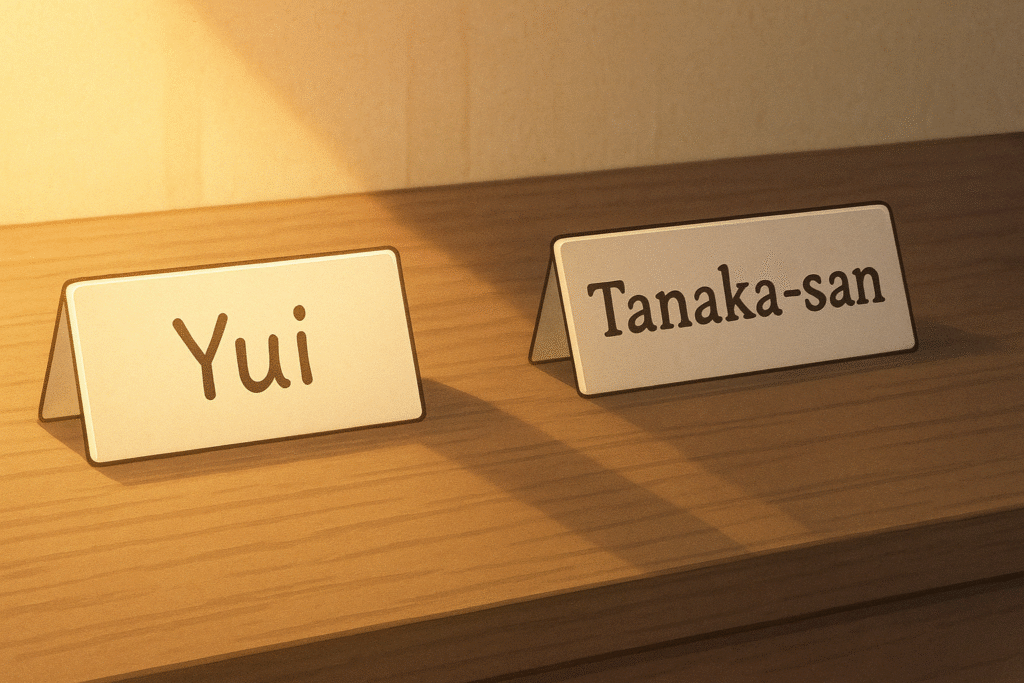Have you ever watched anime or read manga and wondered, “What does kun mean?” You’re not alone! Japanese honorifics like -kun play a crucial role in Japanese communication, helping to establish relationships, show respect, and navigate social hierarchies. In this comprehensive guide, we’ll explore what kun means, when to use it, and how it fits into the broader system of Japanese honorifics.
Understanding Japanese Honorifics: The Foundation
Japanese honorifics are suffixes attached to names that indicate the relationship between the speaker and the person they’re addressing or referring to. These tiny additions might seem simple, but they carry significant social weight in Japanese culture.
As we explored in our article on Japanese transition words, language elements that might seem minor can actually be fundamental to communication. Honorifics are a perfect example of this principle.
What does kun mean? Kun (-くん) is an informal honorific primarily used for male friends, classmates, and colleagues who are of the same age or younger than the speaker.
When to Use Kun: Social Context Matters
The Japanese honorific kun is typically used in these situations:
- Among male friends: Particularly common among school-aged boys
- In professional settings: When superiors address male subordinates
- For younger male relatives: Such as cousins or nephews
- Occasionally for females: In school or workplace settings, though this usage is evolving
Let’s look at some examples:
- A teacher addressing a male student: “Tanaka-kun, please read the next paragraph.”
- A manager to a male employee: “Yamada-kun, could you prepare those reports?”
- Friends referring to each other: “I’m going to the movies with Kenta-kun.”
Want to explore Japan’s culture?
Discover Japan’s rich culture, traditions, and hidden gems with our expertly crafted guides. Get insider tips on travel, food, and history. All for free!
Kun vs. Other Common Japanese Honorifics
Understanding kun requires placing it in the broader context of Japanese honorific usage. Here’s how it compares to other common honorifics:
San (-さん)
The most versatile and commonly used honorific, san is gender-neutral and shows standard politeness. It’s similar to “Mr.,” “Ms.,” or “Mrs.” in English, but used much more frequently.
Chan (-ちゃん)
A more cutesy, affectionate honorific typically used for:
- Children
- Female friends
- Pets
- Romantic partners
- Anything considered cute
As we noted in our article about the 1000 most common Japanese words, mastering these basic honorifics is essential for everyday communication.
Sama (-さま)
A highly respectful honorific showing great deference:
- Used for customers in business settings
- For addressing people of higher status
- When referring to deities
- In formal written communication
Kun (-くん)
As we’ve explored, kun indicates:
- Familiarity
- Used primarily for males
- Suggests the addressee is of equal or lower status
- Less formal than san
The Cultural Significance of Kun
What does kun mean in terms of cultural significance? In Japanese society, honorifics like kun help maintain harmony by clearly establishing social positions and relationships.
Using kun appropriately signals that you understand your place in the social hierarchy and respect Japanese cultural norms. In a society that values group harmony and proper etiquette, these linguistic markers play an essential role.
Our guide on English and Japanese similarities explores how both languages use markers of formality and respect, though Japanese takes this to a more systematic level with honorifics.
Common Mistakes When Using Kun
When learning Japanese honorifics, foreign speakers often make these mistakes with kun:
- Using it for everyone: Remember, kun is primarily for males of equal or lower status
- Self-application: Never use kun (or any honorific) for yourself
- Dropping it too soon: Don’t drop honorifics unless explicitly invited to do so
- Overusing it with females: While sometimes appropriate, using kun for females requires cultural sensitivity
Beyond Basic Usage: Advanced Applications of Kun
Advanced Japanese speakers should understand these nuanced uses of kun:
- In sports teams: Teammates often use kun regardless of hierarchy
- In political contexts: Politicians sometimes use kun for colleagues
- In certain regions: Some areas of Japan have distinct honorific customs
- With character names: In manga and anime, kun is sometimes attached to a character’s first name rather than family name
Honorific-Free Usage (Yobisute)
The absence of honorifics, called yobisute (呼び捨て), is significant in itself. It indicates:
- Extreme closeness (family, spouses, very close friends)
- Sometimes rudeness if used inappropriately
- Power dynamics (a boss might use yobisute with employees)
So what does kun mean in comparison to using no honorific at all? While kun indicates familiarity, dropping honorifics completely signals an even deeper connection.
Learning to Use Kun Naturally
To incorporate kun naturally into your Japanese:
- Observe native speakers in different contexts
- Start conservatively with more formal honorifics
- Follow the lead of Japanese friends or colleagues
- Consider the setting – professional vs. casual environments require different approaches
Q&A: Common Questions About Kun
What exactly does kun mean in Japanese?
Kun is an honorific suffix attached to names, primarily used for male friends, colleagues, or juniors to express familiarity while maintaining some politeness.
Can kun be used for females?
Yes, kun can sometimes be used for females, particularly in school or workplace settings, though this usage is less common than for males.
Is it rude to use kun with someone you just met?
Generally yes. For new acquaintances, -san is more appropriate until a closer relationship develops.
When should I stop using honorifics altogether?
Only when explicitly invited to do so, typically after developing a very close relationship.
How is kun pronounced?
Kun is pronounced similar to “koon” with a short, clipped sound, not drawn out.
Conclusion: Mastering Japanese Honorifics
Understanding what kun means is just one step in mastering the complex system of Japanese honorifics. These linguistic tools reflect Japan’s emphasis on social harmony, respect, and clear communication of relationships.
As you continue your Japanese learning journey, pay close attention to how honorifics are used in different contexts. Practice with native speakers whenever possible, and don’t be afraid to ask for guidance.
Ready to take your Japanese skills beyond honorifics? Visit our Learn Japanese page for free guides that will help you master everything from basic conversations to advanced reading and writing.
Remember, the proper use of kun and other honorifics isn’t just about correct grammar—it’s about showing respect for Japanese culture and social customs. What does kun mean? At its core, it means you recognize and honor the relationship between yourself and the person you’re addressing.
Love Japan? Stay in the Loop!
Get the best of Japan straight to your inbox: language, culture & travel insights!




